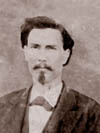|
Mystery solved
No doubt about it, that's what used to be outlaw Bill Longley
 A
long-cherished Texas legend bit the dust-literally-in June when
it was announced that DNA testing definitively identified bones
excavated in Giddings, Texas, three years ago as the remains of
notorious outlaw William Preston Longley. A
long-cherished Texas legend bit the dust-literally-in June when
it was announced that DNA testing definitively identified bones
excavated in Giddings, Texas, three years ago as the remains of
notorious outlaw William Preston Longley.
Longley was a desperado who reportedly killed 32 people, including one woman. Ever since his execution in 1878-which by some accounts drew 4,000 gawkers to Giddings-rumors circulated that "Wild Bill" or "Bloody Bill" had faked the hanging and escaped the noose. Some said the 27-year-old felon fled to Mexico, others that he settled in Nicaragua.
The most persistent rumor placed him in Louisiana, living under the name of Capt. John Calhoun Brown. In fact it was Ted Wax, one of Brown's descendants, who began the search for what really happened. And the escape story did have some credence. Longley had foiled the hangman once before, when the vigilantes who strung him up began shooting and hit the rope, dropping him to the ground.
|
The bones unearthed at the Giddings cemetery in 1998 have been positively identified as those of notorious 19th-century outlaw Wild Bill Longley.
|
 |
The quest to find the real William Longley took Wax to forensic anthropologist Doug Owsley, then a professor at Louisiana State University. Dr. Owsley, in turn, enlisted Brooks Ellwood, at that time a geology professor at UTA with a reputation for locating unmarked burials using sophisticated geophysics. Over the next few years, the professors and their assistants excavated 30 gravesites at the Giddings cemetery but failed to locate Longley.
After further analysis, Dr. Ellwood decided to try one more time. In July 1998, as chronicled in UTA Magazine that fall, Wild Bill was unearthed. At least they were pretty sure it was Wild Bill.
"Using computer imaging from site photography, we identified the spot where we expected to find a burial," said Dr. Ellwood, now chairman of the Geology and Geophysics Department at LSU and a geology adjunct professor at UTA. "We tested that site and found a burial. When we excavated, we identified in the ground a person who was the right age, right race and right sex. When digging, I found a Catholic medal on his chest (Longley had converted to Catholicism shortly before his death) and many other indications that made it very clear that we had the right guy.
"When Doug wanted to do the DNA, I opposed spending the money because I knew we had him-there was no question in my mind. But Doug was not as convinced. I agreed to pay half of the cost, and the DNA confirmed what I already knew."
Dr. Owsley, who now works with the Smithsonian Institution, took the remains to Washington, D.C., where he tried unsuccessfully to reconstruct Longley's facial bones. A restored face to match with known photographs of Longley would have provided another means of identification. Still, the DNA testing was conclusive. For the test, Dr. Owsley matched a sample from Wild Bill's tooth to a blood sample from one of Longley's sister's descendants.
Wax, who initially favored DNA as the final answer to his questions, now doubts the results. He says Dr. Owsley "simply made a mistake."
But Dr. Ellwood is certain of the outcome.
"I told him long ago that there was no question," he said. "We had our man."
- SWN
|

